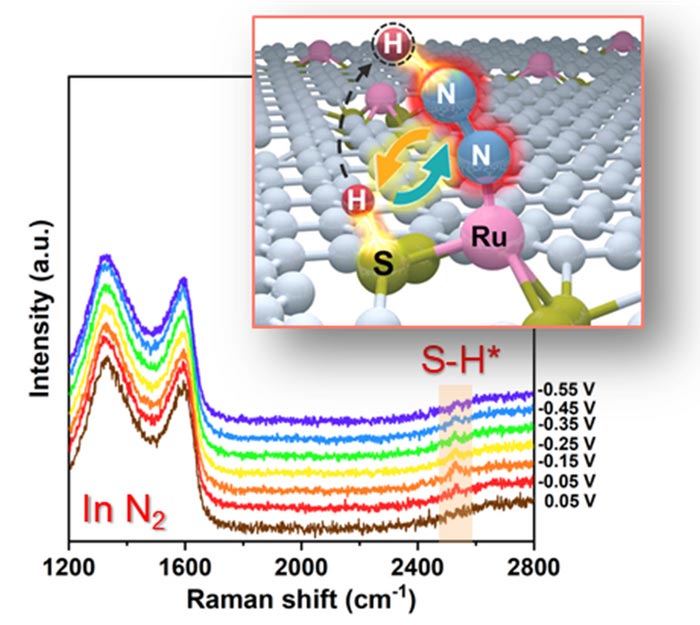Electrochemical nitrogen reduction on Ru‐S‐C single‐atom catalyst

Using in situ Raman spectroscopy and dynamic kinetic effect, the researchers have experimentally confirmed the positive effect of the Ru/S dual-site mechanism on eNRR over a model Ru-S-C single-atom catalyst.
Credit: Chinese Journal of Catalysis
Ammonia (NH3) is a substantial important fertilizer and chemical for human society, however, its production by the traditional Haber-Bosch process consumes substantial fossil fuel energy and produces massive carbon dioxide emissions. Powered by renewable energy, electrocatalytic reduction of nitrogen (N2) to NH3 under eco-friendly and mild conditions provides a highly attractive solution to carbon neutrality. Despite recent significant progress, electrocatalytic nitrogen reduction reaction (eNRR) still suffers from limited selectivity and activity. This is due to the super-stability of N≡N triple bond. Theoretical and experimental efforts have demonstrated that the electrocatalysts always face a significant challenge to effectively activate N2 and accomplish the first protonation of N2 to form NNH* in the rate-determining step (RDS).
One strategy to break the above limitation of eNRR is to involve multi-reaction sites in catalytic reactions, just like the catalytically active sites in talented metalloenzymes. For instance, in Fe nitrogenase, the S atom adjacent to the Fe centre functions as a co-catalytic site to bind protons (H*), which electrostatically activates the N2 molecule adsorbed by the Fe centre to the optimum state and provides H* for the hydrogenation of N2. Such a close collaboration between the metal centre and its coordination atoms enables the nitrogenase to achieve ultrahigh activity and selectivity. Therefore, one can expect that the synergetic work of multiple catalytic sites on the catalyst surface can significantly enhance the activity and selectivity of eNRR.
Recently, a research team led by Prof. Tao Ling from Tianjin University, China, proposed to realize a synergetic work of multi-reaction sites to overcome the limitation of sustainable NH3 production. Herein, using ruthenium-sulfur-carbon (Ru-S-C) catalyst as a prototype, the researchers show that the Ru/S dual-site cooperates to catalyse eNRR at ambient conditions. With the combination of theoretical calculations, in situ Raman spectroscopy, and experimental observation, the researchers demonstrate that such Ru/S dual-site cooperation greatly facilitates the activation and first protonation of N2 in the rate-determining step of eNRR. As a result, Ru-S-C catalyst exhibits significantly enhanced eNRR performance compared with the routine Ru-N-C catalyst via a single-site catalytic mechanism. It can be anticipated that the specifically designed dual-site collaborative catalytic mechanism will open up a new way to offer new opportunities for advancing sustainable NH3 production. The results were published in Chinese Journal of Catalysis (https://doi.org/10.1016/S1872-2067(22)64136-6).
About the Journal
Chinese Journal of Catalysis is co-sponsored by Dalian Institute of Chemical Physics, Chinese Academy of Sciences and Chinese Chemical Society, and it is currently published by Elsevier group. This monthly journal publishes in English timely contributions of original and rigorously reviewed manuscripts covering all areas of catalysis. The journal publishes Reviews, Accounts, Communications, Articles, Highlights, Perspectives, and Viewpoints of highly scientific values that help understanding and defining of new concepts in both fundamental issues and practical applications of catalysis. Chinese Journal of Catalysis ranks among the top two journals in Applied Chemistry with a current SCI impact factor of 12.92. The Editors-in-Chief are Profs. Can Li and Tao Zhang.
At Elsevier http://www.journals.elsevier.com/chinese-journal-of-catalysis
Manuscript submission https://mc03.manuscriptcentral.com/cjcatal
Media Contact
Fan He
Dalian Institute of Chemical Physics, Chinese Academy Sciences
hef197@dicp.ac.cn
Office: 86-411-843-79240
All latest news from the category: Life Sciences and Chemistry
Articles and reports from the Life Sciences and chemistry area deal with applied and basic research into modern biology, chemistry and human medicine.
Valuable information can be found on a range of life sciences fields including bacteriology, biochemistry, bionics, bioinformatics, biophysics, biotechnology, genetics, geobotany, human biology, marine biology, microbiology, molecular biology, cellular biology, zoology, bioinorganic chemistry, microchemistry and environmental chemistry.
Newest articles

Molecular gardening: New enzymes discovered for protein modification pruning
How deubiquitinases USP53 and USP54 cleave long polyubiquitin chains and how the former is linked to liver disease in children. Deubiquitinases (DUBs) are enzymes used by cells to trim protein…

Machine learning accelerates catalyst discovery
Conceptual blueprint to analyze experimental catalyst data. Machine learning (ML) models have recently become popular in the field of heterogeneous catalyst design. The inherent complexity of the interactions between catalyst…

More efficient car designs with AI
8,000 open source models for sustainable mobility. Designing new cars is expensive and time consuming. As a result, manufacturers tend to make only minor changes from one model generation to…



